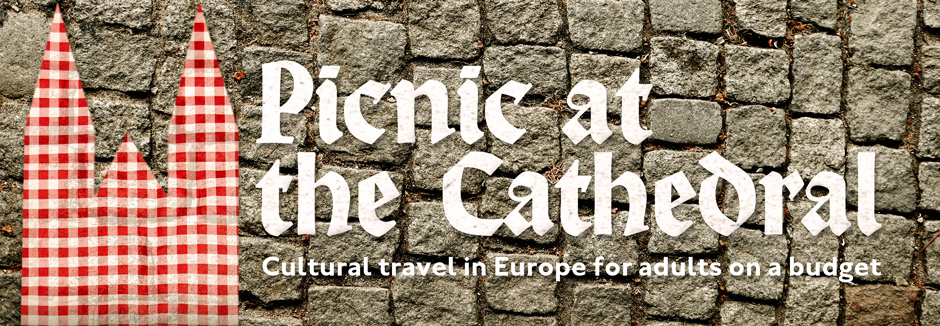We were all alone in Vézelay’s Sainte-Marie-Madeleine Abbey, the light was fading, darker, darker…and then we climbed down into the crypt. No, not actually a horror story ending, but in fact the ending to a perfect day, a day we spent from sunup to sundown in and around one of the world’s greatest Romanesque churches.
Vézelay is a starting point of one of the four main pilgrimage routes to Santiago de Compostela and is such a lovely town that it must attract plenty of tourists, but during our visit we saw few other people. Both the abbey and the hill it stands on are a UNESCO World Heritage Site. The abbey is named after St. Mary Madeleine whose (rather dubious) relics were said to be housed in the crypt, though we didn’t see them in our almost pitch dark sprint through that spooky space. The real draw of the abbey to me, besides the idyllic countryside of France’s Burgundy region, was the indulgently weird yet still comprehensively narrative sculptural stone carvings in the narthex and on the column capitals. 900 years of pilgrims have made their way through Vézelay until one day it was our turn to walk under the carved tympanum with it’s lanky and huge-handed Christ to gawp all day at the figured capitals in the changing light. Our hotel, just as charming as the rest of the town, was situated immediately next to the church, so we figured we could say we almost slept in the abbey too. Experiencing art in situ is always a treat: in Vézelay it was absolutely bewitching.
The West facade was mostly reconstructed in the 19th century, though the tower is original c. 1150-1250. The good stuff is inside.
The South facade has Gothic details.
The narthex was gathering point for pilgrims during medieval times. The North portal tympanum depicts the resurrection of Christ. Both tympanums c. 1125 -1130
The main tympanum is jam-packed with complicated iconography and unfortunately our pictures don’t do it justice. In the center Christ is gesturing “I am the way!” causing Holy Ghost-filled flames to flow from his hands on to his apostles below. The mission of the apostles is this: take those scriptures you’re holding and spread the gospel. No, seriously guys, go everywhere, to the ends of the earth if you must. Find some freaky people in far off lands. Giants? Convert them. Heathens sacrificing a bull? Convert. Giants, pygmies so tiny they need a ladder to climb onto a horse, Ethiopians with pig-snouts, lepers; convert, convert, CONVERT!
Panotians, the elephant ear people, were said to live on the awesomely named All-Ears Islands off Scythia. (Funny, I don’t remember studying this particular tribe in my anthropology class.)
Romanesque nave with an early Gothic choir: truly a divine and luminous interior.
In the nave facing West.
This floor plan of the the basilica is from Wikipedia, which I’m posting so we can all snicker about how phallic it is. (Though the nave faces East, it would seem more apropos for it to face North, eh?)
Loves me some Romanesque!
The Mystic Mill capital carving. Moses (with the swirly-hip) is grinding the “grain” of the Old Testament into the “flour” of the New Testament. St. Paul is holding the sack.
I’m not sure what this capital carving depicts, so I’ll call it The Alice in Wonderland.
Moses and the Golden Calf.
David Decapitating Goliath.
St. Benedict Raising a Farmer’s Son from the Dead.
Dude is doing the “Gotta pee–where the john?” dance.
Looking at the yummy countryside and vineyards surrounding Vézelay it’s easy to understand why pilgrims from medieval times to the present day would want to walk through here on the way to Santiago de Compestela.
There are optimal picnicking spots behind the church, though I recommend bringing all your food with you to Vézelay. We plundered the town’s tiny grocery in desperation, resulting in several meals of pâté, crackers, applesauce and a type of spongy cookie called nonnets (though I’m unclear of the spelling, they were tasty.)
Our pretty hotel, right next to the abbey.
How we got to Vézelay: bus and taxi from Semur-en-Auxois.
Where we slept: Les Glycines Vézelay. Price: €69 for a double. Recommended: yes.





















No anthropophagi?
LikeLike
There wasn’t enough room for all the monstrous tribes, but certainly the anthropophagi were there in spirit.
LikeLike
It’s a beautiful church! The elephant people are strange though. People/designers must’ve been really bored back then, coming up with all those tiny symbolism statues!
LikeLike
Thanks nomadicpanda. Those artist weren’t making all of those fantastic tribes up–they got it from Pliny the Elder, who had written about it a long time in the past, and a lot of people believed that the unexplored world really had these crazy people (and there really are pygmies so they were a bit right). Check this out:
http://www.theoi.com/greek-mythology/fabulous-tribes.html
LikeLike
The nave of the Abbey is impressive !
LikeLike
Yes it is, and huge too (bigger than Notre Dame in Paris).
LikeLike
Love those capitals, I miss Vezelay!
LikeLike
Did you start the camino there?
LikeLike
My pilgrim’s credential says I did, but actually, I started from Sermizelles and walked for an hour or so from the train station there to Vezelay 🙂
LikeLike
Gotta be accurate! : )
LikeLike
The each rock of the inside in the church carvings is all interesting story .
LikeLike
So true!
LikeLike
Reblogged this on artbazarblog.
LikeLike